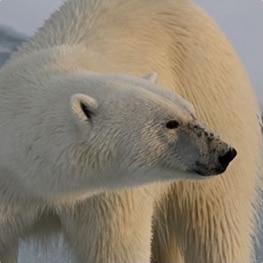Polar Bears – 10 Amazing Facts

WWF have recently been celebrating the largest land predator in the world – the polar bear. These incredible animals are severely threatened by habitat change.
Polar bears have adapted to survive in the harsh Arctic weather, but they rely on sea ice to travel, find food and find a mate. However, climate change is pushing them to the brink as the sea ice is in decline. This forces the bears to come in closer contact with humans, and causes concern over the safety of people and their dwellings.
In support of these amazing animals here are 10 polar bear facts:
1. Skin colour
Polar bears skin is in fact black. Their white fur is actually translucent and reflects the light which gives them their white appearance. Their apparent fur colour helps them blend in with their icy surroundings, which is ideal when hunting.
2. As heavy as a small car
They are very large. Adult polar bears can be over 2.5m long and weigh over 600kg. Their huge size and weight make them the largest living carnivores on Earth.
3. Ice dwellers
Although good swimmers, polar bears aren’t quick enough to regularly catch seals their food of choice) in open water. Instead, they depend on the ice as a hunting platform. They wait near seal breathing holes or at the ice’s edge for a seal to surface.
4. Endangered
The biggest threat to polar bears is climate change. Rising global temperatures means that sea ice is melting earlier and forming later each year, leaving polar bears less time to hunt for food.
5. Long distances covered
As well as being great swimmers they can walk long distances too. They have large paws that can be 30cm wide with bumpy footpads that help them to grip the icy floor. These big grippy paws mean that they can travel up 3,000 kilometers per month and have home ranges bigger than most countries.
6. Cubs born in snow dens
Female polar bears give birth to their cubs in snow dens in November and December. They have to shelter at that time of year so as to be out of the harsh Arctic weather. When the cubs are born, they are about 30cm long, and weigh around half a kg, which is about the size of an adult guinea pig!
7. Growing up
A polar bear mum will usually spend about two months in the den before her cubs are born. Once her cubs are born they will grow quickly but won’t venture into the outside world until about three months later. The cubs will stay with their mother for about two years, during which time they learn the skills needed to survive in the Arctic.
8. Pizzly bears
Pizzly bears aren’t common but their numbers are on the increase. Pizzly’s are a hybrid of a grizzly bear and polar bear. Their existence is due to polar bears being forced to retreat to land during the summer months as climate change is melting their icy homes. This means the polar bears end up where grizzly bears roam. Pizzly bears have light brown fur with the slim, pointed snout of a polar bear and the big bulky shoulders of a grizzly bear.
9. Marine mammals
They spend a lot of their time on the ocean ice so much so that they are considered marine mammals. They are excellent swimmers, and have been spotted in waters over 100km offshore. They can comfortably swim at around 10km/h using their slightly webbed, 30cm wide paws like paddles in the water.
10. Keen sense of smell
They have an incredible sense of smell which they use to track seals*. In fact, their sense of smell is so good, they can sniff out prey from up to 16km away!
WWF are working with governments, industry and individuals to reduce greenhouse gas emissions and try and reduce climate change. However, they need funding to make this happen. Adopting a polar bear through WWF will help protect the bears, and it will help fund vital work raising awareness of climate change. Please visit our Polar Bear adoption page for further information.



